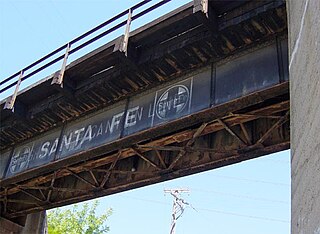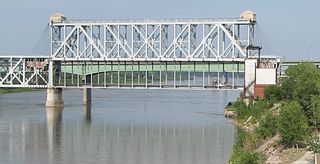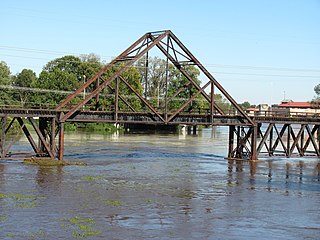
A truss is an assembly of members such as beams, connected by nodes, that creates a rigid structure.

A truss bridge is a bridge whose load-bearing superstructure is composed of a truss, a structure of connected elements, usually forming triangular units. The connected elements, typically straight, may be stressed from tension, compression, or sometimes both in response to dynamic loads. There are several types of truss bridges, including some with simple designs that were among the first bridges designed in the 19th and early 20th centuries. A truss bridge is economical to construct primarily because it uses materials efficiently.

Dr. John Alexander Low Waddell was a Canadian-American civil engineer and prolific bridge designer, with more than a thousand structures to his credit in the United States, Canada, as well as Mexico, Russia, China, Japan, and New Zealand. Waddell’s work set standards for elevated railroad systems and helped develop materials suitable for large span bridges. His most important contribution was the development of the steam-powered high-lift bridge. Waddell was a widely respected writer on bridge design and engineering theory, as well as an advocate for quality in higher education engineering programs. The company he founded in 1887, 'J.A.L. Waddell, Consulting Engineer,' would eventually become the modern day Hardesty & Hanover, a leading moveable bridge engineering firm. Many of Waddell's surviving bridges are now considered historic landmarks.

A plate girder bridge is a bridge supported by two or more plate girders.

The Armour-Swift-Burlington (ASB) Bridge, also known as the North Kansas City Bridge and the LRC Bridge, is a rail crossing over the Missouri River in Kansas City, Missouri, that formerly also had an upper deck for automobile traffic.

A Howe truss is a truss bridge consisting of chords, verticals, and diagonals whose vertical members are in tension and whose diagonal members are in compression. The Howe truss was invented by William Howe in 1840, and was widely used as a bridge in the mid to late 1800s.

The Bahia Honda Rail Bridge is a derelict railroad bridge in the lower Florida Keys connecting Bahia Honda Key with Spanish Harbor Key. It was originally part of the Overseas Railway, but the state of Florida purchased it from the Florida East Coast Railway (FEC) after the 1935 Labor Day Hurricane and converted it for automobile use as part of the Overseas Highway in 1938. After a replacement Bahia Honda Bridge was opened in 1972, two spans of the old bridge were removed for the safety of boat traffic and to prevent pedestrian access to unsafe parts of the bridge.

The Kansas City Southern Railroad Bridge (Cross Bayou), in downtown Shreveport, Louisiana, is an "A" Truss bridge erected in its current location in 1926 and abandoned in the 1980s. Due to its national significance to the progress of American bridge design, and its rarity as one of only two known surviving examples, the structure was designated a National Historic Place in 1995.

A timber roof truss is a structural framework of timbers designed to bridge the space above a room and to provide support for a roof. Trusses usually occur at regular intervals, linked by longitudinal timbers such as purlins. The space between each truss is known as a bay.

The Hadley Parabolic Bridge, often referred to locally as the Hadley Bow Bridge, carries Corinth Road across the Sacandaga River in Hadley, New York, United States. It is an iron bridge dating from the late 19th century.

The Clinton Falls Bridge, also known as the Old Mill Bridge and formally as Bridge L-5573, is a historic steel Pratt through truss bridge that spans the Straight River in Clinton Falls Township, Minnesota. It was listed on the National Register of Historic Places in 1997 as Bridge No. L-5573 for having local significance in the theme of engineering. It was nominated for being an example of early steel truss bridge design in Minnesota.

The Waddell "A" Truss Bridge, also known by its original name of Linn Branch Creek Bridge is one of two surviving examples of the "A" Truss Bridge type originated by John Alexander Low Waddell. It was originally completed in 1898 near Trimble, Missouri, and is currently located at English Landing Park in Parkville, Platte County, Missouri. The bridge was relocated in 1987 and listed on the National Register of Historic Places in 1991.

The Bethanga Bridge is a steel truss road bridge that carries the Riverina Highway across Lake Hume, an artificial lake on the Murray River in Australia. The dual heritage-listed bridge crosses the border between the Australian states of New South Wales and Victoria, linking the Victorian towns of Bellbridge and Bethanga with the regional New South Wales city of Albury.

Sadliers Crossing Railway Bridge is a heritage-listed railway bridge at over Bremer River between Tallon Street, Sadliers Crossing and Dixon Street, Wulkuraka, Queensland, Australia on the Main Line (this section is now the Ipswich and Rosewood railway line. It was added to the Queensland Heritage Register on 13 November 2008.

The Straight Street Bridge is a vehicular bridge over the Passaic River in Paterson, New Jersey, that is listed on the National Register of Historic Places.

Old Cobram-Barooga Bridge is a heritage-listed former road bridge and now footbridge over the Murray River at Barooga-Cobram Road, Barooga, New South Wales, Australia. The bridge links Barooga with Cobram, its sister town in Victoria. It was designed by Ernest de Burgh (engineer) and the New South Wales Department of Public Works and built from 1900 to 1902. It is also known as RMS Bridge No 3247. It is owned by Transport for NSW. It was added to the New South Wales State Heritage Register on 1 April 2016.

The Parshallburg Bridge, also known as the Ditch Road Bridge, was a bridge that originally carried Ditch Road over the Shiawassee River near Oakley, Michigan. It was listed on the National Register of Historic Places in 1994. It was the only known Thacher through truss bridge in Michigan, and one of only a few remaining in the nation. In 1999, the bridge was moved to a new location, and in 2008 was washed off its piers and destroyed.

Joseph Tomlinson was an English American engineer and architect who built bridges and lighthouses in Canada and the United States. In 1868, he co-designed and oversaw the construction of the Hannibal Bridge, the first permanent crossing of the Missouri River. He was the first person to hold the position of General Superintendent of Lighthouses for the new Dominion of Canada, holding that position beginning in January 1870. For eight years, he worked building railroad bridges for the Canadian government, and designed one of the most impressive bridges on the Canadian Pacific Railway where it crossed the Fraser River. He designed a railroad bridge over the Ashtabula River in Ohio, but was fired from the project after he refused to make supervisor-ordered changes to the design which he considered unsafe. The bridge failed on December 29, 1876, killing 92 people in a train derailment.

Manzanola Bridge was a truss bridge which was originally built in 1911 by the Patterson-Burghardt Bridge Company over the Colorado River and later moved over the Arkansas River in the year 1950. The bridge used to connect the town of Manzanola, Otero County, with Crowley County in Colorado.

H&H is an American infrastructure engineering company specializing in the design and management of bridges and other transportation and architecture projects. The firm was founded in 1887 by John Alexander Low Waddell, a structural engineer who pioneered the design of large-scale moveable bridge. Originally incorporated in Kansas City, Missouri as J.A.L. Waddell, Consulting Engineer, the company was renamed throughout the early 20th century as Waddell added junior partners to the organization. In 1920, the firm moved its headquarters to New York City, where it would go on to design many important bridges int the area, such as Newark Bay Bridge (rail), the original Goethals Bridge, and Marine Parkway Bridge.





















